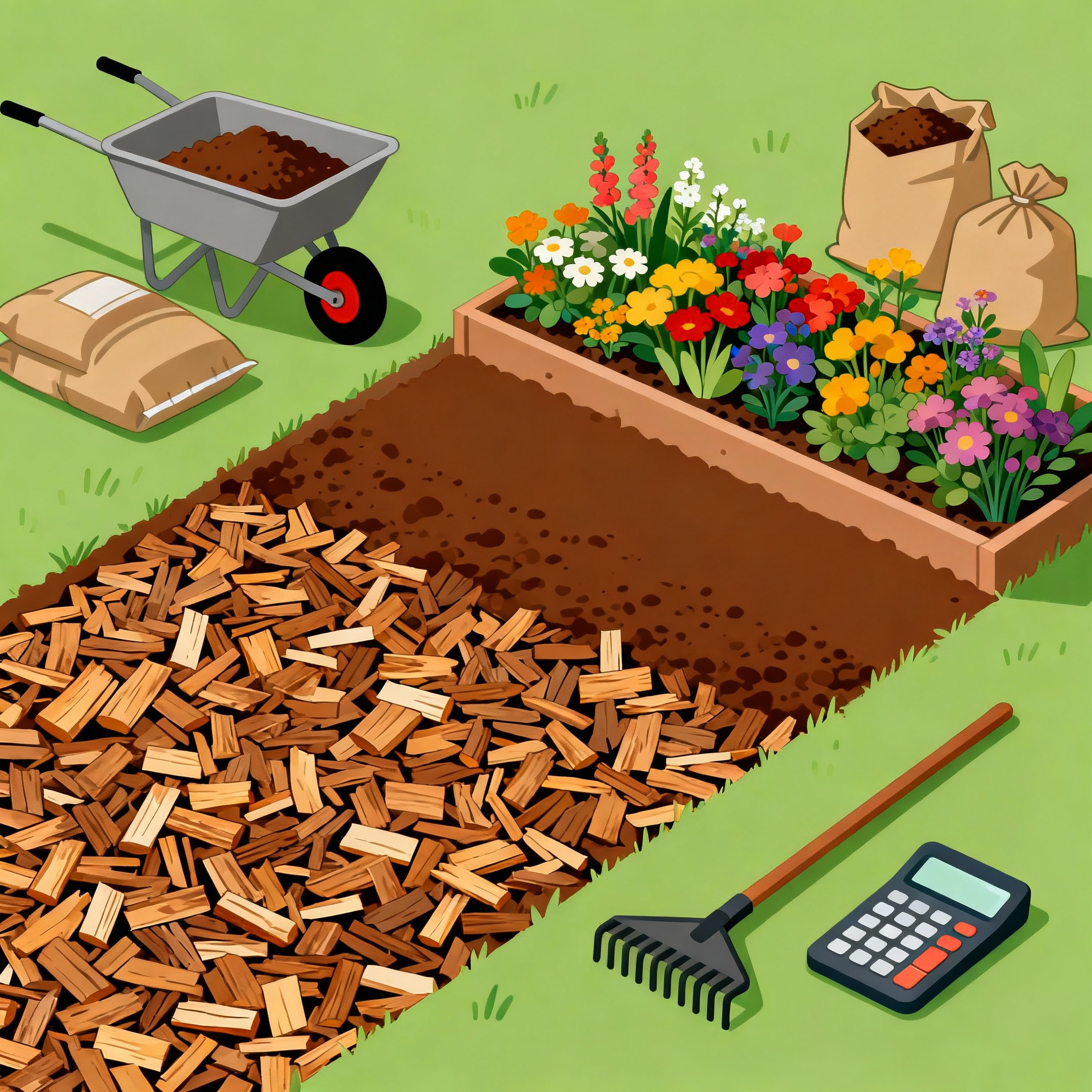Basic Mulch Calculator
Advanced Mulch Calculator
Mulch Types & Selection Guide
🌲 Wood Chips
Cost: $25-$40 per cubic yard
Longevity: 2-3 years
Best for: Trees, shrubs, pathways
- Natural appearance
- Good weed suppression
- Improves soil as it decomposes
- Available in various colors
🍂 Shredded Bark
Cost: $30-$50 per cubic yard
Longevity: 3-4 years
Best for: Flower beds, slopes, erosion control
- Interlocks to resist washing
- Attractive texture
- Slow to decompose
- Good moisture retention
🌱 Compost Mulch
Cost: $20-$35 per cubic yard
Longevity: 1-2 years
Best for: Vegetable gardens, annual beds
- Adds nutrients to soil
- Improves soil structure
- Dark, finished appearance
- Fast decomposition (benefit)
🌾 Straw/Hay
Cost: $5-$15 per bale
Longevity: 1 season
Best for: Vegetable gardens, winter protection
- Very inexpensive
- Easy to spread
- Good for temp gardens
- May contain weed seeds
🪨 Rubber Mulch
Cost: $50-$90 per cubic yard
Longevity: 10+ years
Best for: Playgrounds, high-traffic areas
- Extremely durable
- Won’t decompose
- No soil benefits
- Various colors available
🍃 Pine Needles
Cost: $25-$40 per cubic yard
Longevity: 2-3 years
Best for: Acid-loving plants, slopes
- Natural pine appearance
- Stays in place on slopes
- Slightly acidic
- Clean, neat look
🌰 Cocoa Hulls
Cost: $60-$100 per cubic yard
Longevity: 2-3 years
Best for: Flower beds, decorative areas
- Rich brown color
- Pleasant chocolate aroma
- Fine texture
- Toxic to dogs (caution!)
🪨 Stone/Rock
Cost: $40-$80 per cubic yard
Longevity: Permanent
Best for: Desert landscapes, driveways
- Never needs replacing
- No decomposition
- Clean appearance
- Reflects heat (pro/con)
🎯 Selection Tips
- ✓ For vegetables: Use compost or straw mulch (adds nutrients)
- ✓ For perennials: Shredded bark or wood chips (long-lasting)
- ✓ For slopes: Shredded bark or pine needles (stay in place)
- ✓ For acid lovers: Pine needles or oak leaves
- ✓ For low maintenance: Rubber or stone (no replacement)
- ✓ For budget: Straw or wood chips (most affordable)
⚠️ Application Guidelines
- • Apply 2-4 inches deep for optimal results
- • Keep mulch 2-3 inches away from plant stems/trunks
- • Remove old mulch before adding new if depth exceeds 4 inches
- • Replenish annually or as needed based on decomposition
- • Water area before and after mulching
- • Use landscape fabric underneath for extra weed control
Mulch Calculator User Guide
What It Does:
This calculator helps you determine the exact amount of mulch needed for landscaping projects, compares bagged vs. bulk pricing, and provides guidance on selecting the right mulch type for your specific needs.
How to Use:
📐 Basic Calculator
Quick mulch calculation for rectangular areas.
- Enter Dimensions:
- Length – Area length in feet
- Width – Area width in feet
- Set Mulch Depth:
- Enter desired depth in inches
- Recommendations:
- Gardens/flower beds: 2-3 inches
- Trees and shrubs: 3-4 inches
- Pathways: 3-4 inches
- New beds: 4 inches
- Calculate:
- Click “Calculate Mulch”
- Results show:
- Total area coverage
- Cubic feet needed
- Cubic yards (for bulk orders)
- Number of 2 cu ft bags
- Number of 3 cu ft bags
- Follow Application Tips:
- Use the bag count or cubic yards
- Keep mulch away from stems
- Apply evenly
⚙️ Advanced Calculator
Calculate mulch with cost comparison and custom shapes.
- Select Area Shape:
- Rectangular/Square – Standard beds
- Circular – Round flower beds, tree rings
- Custom Area – Irregular shapes (enter sq ft)
- Enter Measurements:
- For rectangular: Length and width
- For circular: Diameter
- For custom: Total square footage
- Set Mulch Depth:
- Enter thickness in inches
- Adjust based on purpose
- Choose Bag Size:
- 2 cubic feet (standard)
- 3 cubic feet (large)
- 1.5 cubic feet (small)
- Enter Bag Price:
- Input cost per bag
- Typical range: $2-$7 per 2 cu ft bag
- Check local prices
- Calculate:
- Click “Calculate Mulch”
- Results include:
- Total mulch volume needed
- Number of bags required
- Total bagged cost
- Estimated bulk cost
- Cost comparison/savings
- Review Cost Analysis:
- Compare bagged vs. bulk pricing
- Bulk typically better for 200+ sq ft areas
- Consider delivery fees
🎨 Mulch Types Guide
Comprehensive reference for selecting the right mulch.
What’s Included:
- Wood Chips ($25-$40/cu yd)
- Longevity: 2-3 years
- Best for: Trees, shrubs, pathways
- Benefits: Natural look, improves soil
- Shredded Bark ($30-$50/cu yd)
- Longevity: 3-4 years
- Best for: Flower beds, slopes
- Benefits: Interlocks, erosion control
- Compost Mulch ($20-$35/cu yd)
- Longevity: 1-2 years
- Best for: Vegetable gardens
- Benefits: Adds nutrients, enriches soil
- Straw/Hay ($5-$15/bale)
- Longevity: 1 season
- Best for: Vegetable gardens, winter protection
- Benefits: Very inexpensive, temporary
- Rubber Mulch ($50-$90/cu yd)
- Longevity: 10+ years
- Best for: Playgrounds, high-traffic
- Benefits: Extremely durable, no decomposition
- Pine Needles ($25-$40/cu yd)
- Longevity: 2-3 years
- Best for: Acid-loving plants, slopes
- Benefits: Stays in place, slightly acidic
- Cocoa Hulls ($60-$100/cu yd)
- Longevity: 2-3 years
- Best for: Decorative flower beds
- Benefits: Pleasant aroma, rich color
- ⚠️ Toxic to dogs
- Stone/Rock ($40-$80/cu yd)
- Longevity: Permanent
- Best for: Desert landscapes, driveways
- Benefits: Never needs replacing
Selection Tips:
- Vegetables: Compost or straw (adds nutrients)
- Perennials: Bark or wood chips (long-lasting)
- Slopes: Shredded bark or pine needles
- Acid lovers: Pine needles
- Low maintenance: Rubber or stone
- Budget: Straw or wood chips
Application Guidelines:
- Apply 2-4 inches deep
- Keep 2-3 inches away from stems/trunks
- Remove old mulch if depth exceeds 4 inches
- Replenish annually as needed
- Water before and after application
- Consider landscape fabric underneath
Quick Tips:
✅ Buy bulk for large areas – Cheaper than bags for 200+ sq ft
✅ Apply 2-4 inches deep – Optimal weed suppression and moisture retention
✅ Keep away from stems – Prevents rot and pest issues
✅ Replenish annually – Mulch decomposes over time
✅ Match mulch to purpose – Different types for different needs
Pro Tip: Calculate 10-15% extra mulch to account for settling and uneven application. It’s better to have a little extra than run short mid-project!

Angelina Everly leads the editorial desk at Live Green Gardens, blending practical plant care, hands-on product testing, and approachable outdoor styling. She focuses on step-by-step how-tos, buyer’s guides, and small-space makeovers that work in real life and real budgets. When she’s not comparing pruning shears or setting up a drip kit, you’ll find her creating cozy corners with planters, solar lights, and pollinator-friendly picks—always with clear pros/cons and safety notes so you can buy once and garden happy.

